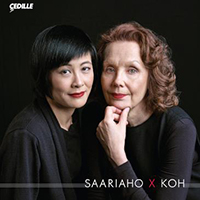Audiophile Audition
By Steven Ritter
March 6, 2019
original link
SAARIAHO X KOH” = Kaija Saariaho: Tocar; Cloud Trio; Light and Matter; Aure; Graal theatre (Violin Concerto) – Jennifer Koh, violin/ Nicolas Hodges, piano/ Hsin-Yun Huang, viola/ Wilhelmina Smith, piano/ Anssi Karttunen, cello/ Curtis 20/21 Ensemble/ Conner Gray Covington – Cedille CDR 90000 183, 68:06 *****:
Kaija Saariaho is one of the leading Finnish composers of the last and present centuries. She started out as a pure serialist, but migrated to what is now known—and was coined in 1970—as Spectralism. This pseudo-scientific term does indeed categorize a type of composition that uses sonographic representations and mathematical analysis of sound spectra, whatever that happens to mean to any particular composer. I suppose that if serialism can be used as a starting off point—or even-tempered tonality for that matter—then anything is possible. But, as I never get tired of stating, whatever the technical, musical, or visual stimulation for any work of art is, the proof is in the final pudding. If a piece of music is inspired by Einstein’s Theory of Relativity or Mary had a little lamb, nothing matters if the results aren’t worthwhile.
Saariaho has used a lot of electronics in her music too, and for some this is a non-starter right from the beginning. But hang on—there is none of that on this album, and the composer began her first encounters with music at the age of six with a violin, moving on to piano a couple of years later. The ever-adventurous and intrepid Jennifer Koh heard her music and immediately felt that this was a composer that she had to get to know.
What we get to know are five quite different pieces that demonstrate what all the fuss is about, though if I am honest, I must say that almost seventy minutes of it was a tad trying. Not that the music is bad, but it is very attention-demanding, and its thorny direction, even though the tonality or lack of is not especially difficult, makes for a rather exhausting endeavor. I think listening to it in bits and pieces might prove more winsome in the end, though I do understand the need to stack it all on one disc, and the variety of instrumentation helps a lot.
Tocar for violin and piano means “to touch” in Spanish, and this piece attempts to show how the two instruments can indeed interact and join together, emphasizing as the composer says, “playfulness, joy, or movement.” Cloud Trio invites the listener to engage in the soundscapes provided by the string trio, as the movement of clouds do in the atmosphere. Light and Matter is the most recent work here (2014), a piano trio whose textures are inspired by the play of light and shadow in Morningside Park in New York, when the composer was living there.
Aure is a short piece for violin and cello written in homage to Henri Dutilleux for his 95th birthday, taken from the third movement of his Shadows of Time where a child sings the line from Anne Frank’s diary, “Why us, why the star?” The phrase is woven through the piece’s texture. Finally, the violin concerto Graal theatre, the oldest work here (1994—all the others are from 2009-present) takes its title from the novel by Jacques Roubaud and bases its inspiration on the idea of the theatricality of performance and the tension between the immovable score and its interpretation by the soloist.
Throughout, the performances are marvelous, and the sound, recorded in three locations, remarkably consistent and clear as a bell. A worthwhile disc for the moderately adventurous.
Copyright © Audiophile Audition
© Jennifer Koh, All Rights Reserved. Photography by Juergen Frank. Site by ycArt design studio
